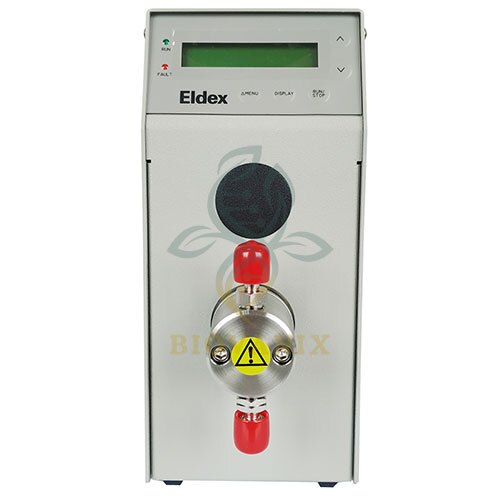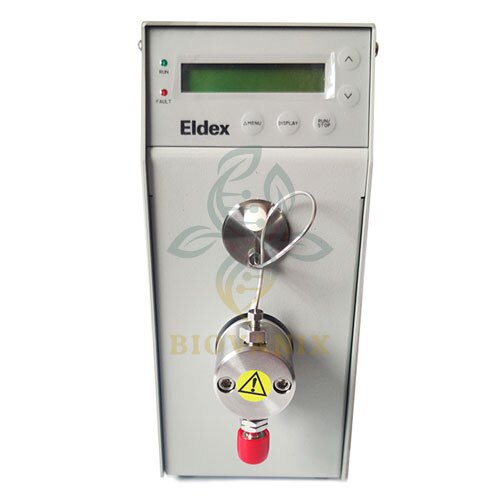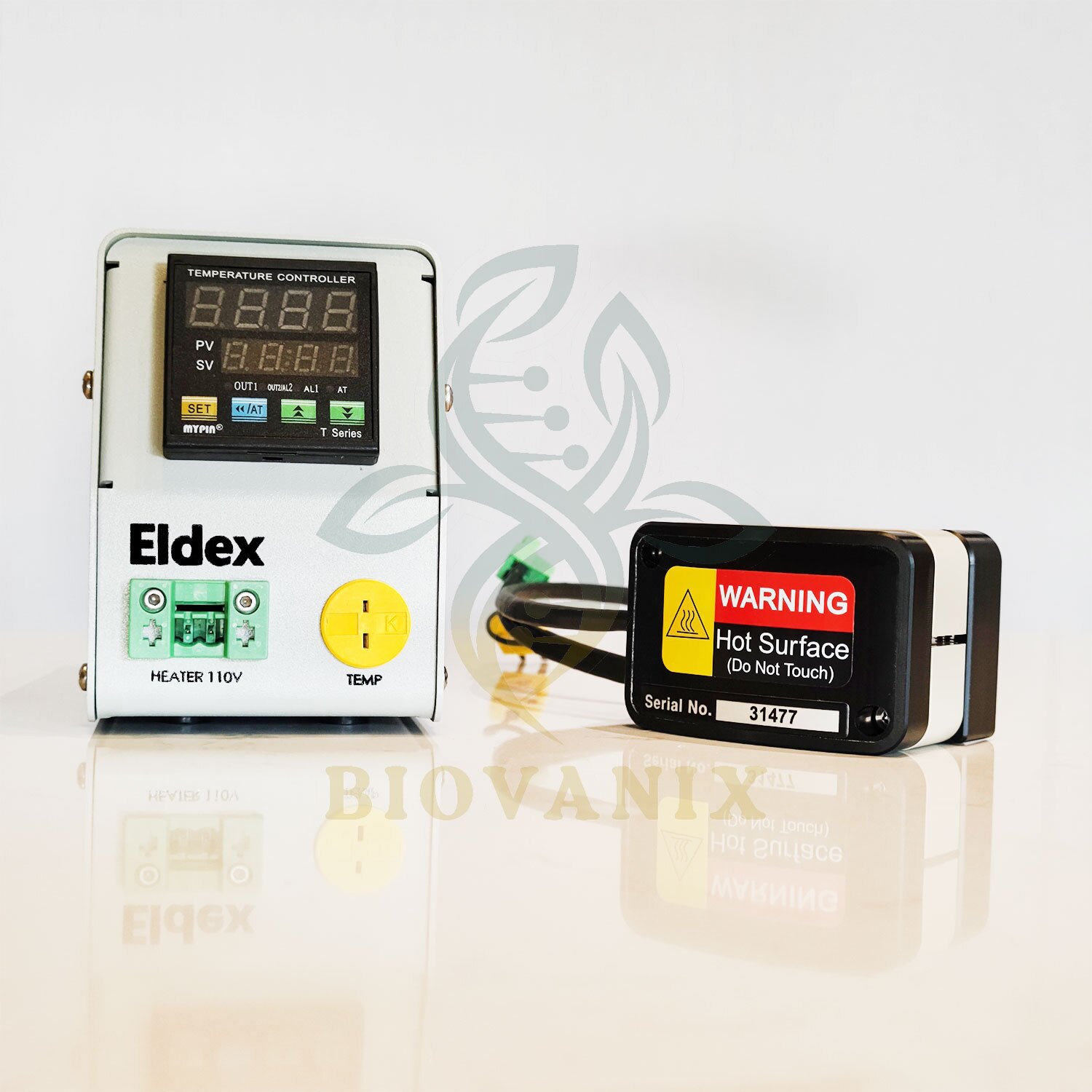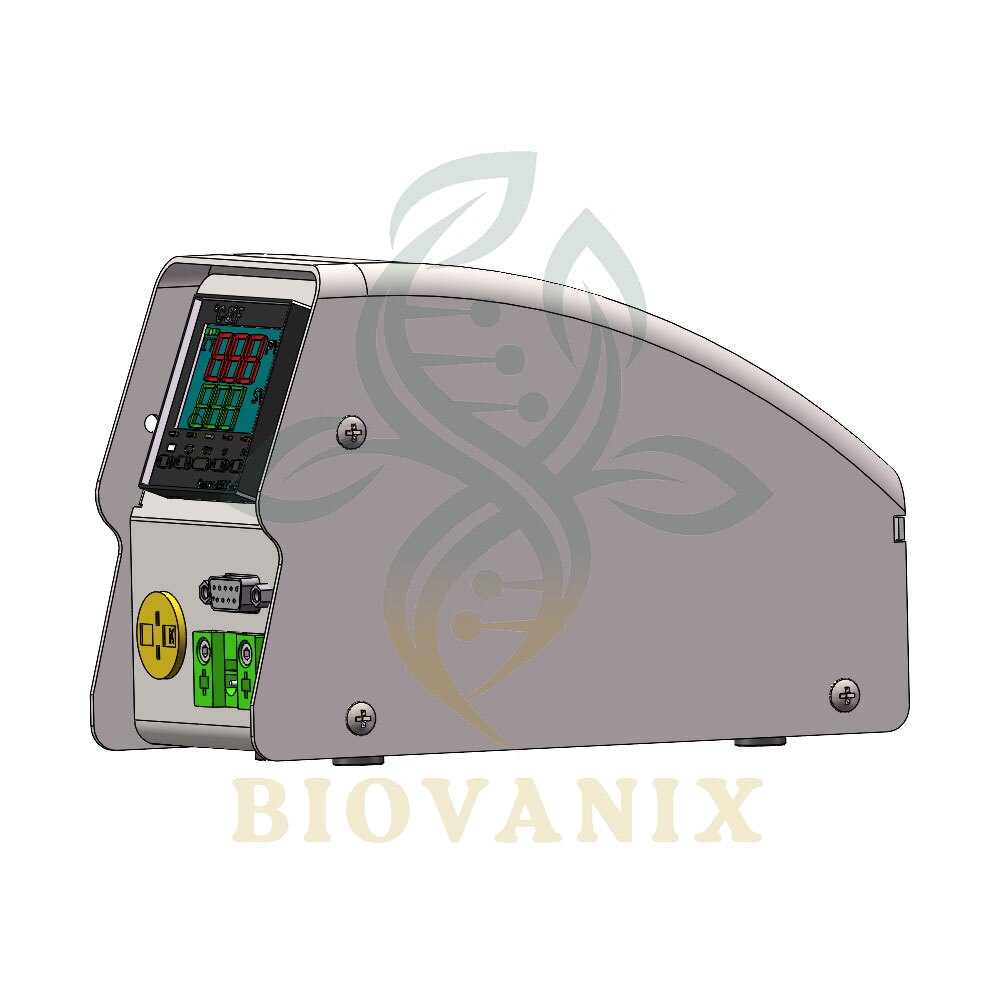High-pressure Precision Plunger Pump
High-pressure precision plunger pump Eldex Optos series supplied by BioVanix are produced in the USA. Integrating the latest technology and electronics, the Eldex Optos pump is designed and manufactured with reciprocating piston pumps for a variety of applications.
- Smooth fluid delivery from intra
- RPM stepper motor control
- Remote flow rate control via analog signal or RS232 command
- Optional liquid ends for expanded flow rate range
- Integrated piston wash system
With the upgrade to Plus Version
- Pressure monitoring with high and low-pressure limits
- Integrated low-volume pulse damper
2.Adjustable flow controls allow manual or remote adjustment of dosing rates (RS232, 0-5V, 4-20mA).
3.Exceptional corrosive resistance to handle harsh or corrosive fluids.
4.Longevity by design and using superior mechanical and electronic components for extended life.
5.Minimized pulsation through pulse dampening accessory and software to optimize refill stroke speed.
6.Remote output options to monitor system flow and pressure activity offsite.
7.Extended flow rate ranges supported by optional liquid ends.
8.Integrated piston wash to flush residues and extend piston seal life.
9.Small footprint enhances portability and maximizes versatility in limited space.
10.Modular design is highly configurable, providing economical customization to accommodate a wide range of applications for end users and OEMs.
11.Heated options – The Hot Head pump accessory can handle fluid temperatures up to 250°F (120 °C), reducing maintenance downtime in heated applications.
Application
Explore the versatility of Eldex reciprocating piston pumps through these application examples:
- HPLC – high pressure liquid chromatography
- Post-column reaction system
- Reactant feed systems / high pressure injection
- Pilot plants
- Hydrocarbon catalyst research and development
- Corrosion testing
- Industrial process
- Any application requiring precision and pressure.
Eldex pumps use a ball and seat check valve design, which lends itself well to applications with clean, low viscosity fluids. However, Eldex pumps are not a good fit for fluids with dissolved particulates (unless filtered) or viscosity above 500cP.
Plunger Pump

Standard Version

Plus Version
Plunger Pump Selection
Model 1
| 316 Stainless Steel Head | Flow Rate (mL/min) | Max. Pressure (psi) | Piston Diameter (in.) | Piston Stroke (in.) | Model |
| 0.002 – 2.5 | 6000 | 3/32 | .125 | 1LM | |
| 0.003 – 5 | 6000 | 1/8 | .125 | 1SM | |
| 0.01 – 20 | 3000 | 1/4 | .125 | 1HM | |
| PEEK Head | Flow Rate (mL/min) | Max. Pressure (psi) | Piston Diameter (in.) | Piston Stroke (in.) | Model |
| 0.002 – 2.5 | 4000 | 3/32 | .125 | 1LI | |
| 0.003 – 5 | 4000 | 1/8 | .125 | 1SI | |
| 0.01 – 20 | 3000 | 1/4 | .125 | 1HI |
Model 2
| 316 Stainless Steel Head | Flow Rate (mL/min) | Max. Pressure (psi) | Piston Diameter (in.) | Piston Stroke (in.) | Model |
| 0.003 – 5 | 6000 | 3/32 | .250 | 2LM | |
| 0.01 – 10 | 6000 | 1/8 | .250 | 2SM | |
| 0.02 – 40 | 1500 | 1/4 | .250 | 2HM | |
| PEEK Head | Flow Rate (mL/min) | Max. Pressure (psi) | Piston Diameter (in.) | Piston Stroke (in.) | Model |
| 0.003 – 5 | 4000 | 3/32 | .250 | 2LI | |
| 0.01 – 10 | 4000 | 1/8 | .250 | 2SI | |
| 0.02 – 40 | 1500 | 1/4 | .250 | 2HI |
Model 3
| 316 Stainless Steel Head | Flow Rate (mL/min) | Max. Pressure (psi) | Piston Diameter (in.) | Piston Stroke (in.) | Model |
| 0.01 – 10 | 3000 | 3/32 | .500 | 3LM | |
| 0.01 – 20 | 1500 | 1/8 | .500 | 3SM | |
| 0.04 – 80 | 750 | 1/4 | .500 | 3HM | |
| PEEK Head | Flow Rate (mL/min) | Max. Pressure (psi) | Piston Diameter (in.) | Piston Stroke (in.) | Model |
| 0.01 – 10 | 3000 | 3/32 | .500 | 3LI | |
| 0.01 – 20 | 1500 | 1/8 | .500 | 3SI | |
| 0.04 – 80 | 750 | 1/4 | .500 | 3HI |
Plus Model
| 316 Stainless Steel Head | Flow Rate* (mL/min) | Max. Pressure (psi) | Piston Diameter (in.) | Piston Stroke (in.) | Model |
| 0.002 – 2.5 | 6000 | 3/32 | .125 | 1LMP | |
| 0.003 – 5 | 6000 | 1/8 | .125 | 1SMP | |
| PEEK Head | Flow Rate (mL/min) | Max. Pressure (psi) | Piston Diameter (in.) | Piston Stroke (in.) | Model |
| 0.002 – 2.5 | 4000 | 3/32 | .125 | 1LIP | |
| 0.003 – 5 | 4000 | 1/8 | .125 | 1SIP |
Operation Videos For Eldex Optos Pumps
Pump Head Heater

Standard Version
Temperature: 100-150℃
Power: 110V
Head Sleeve: Stainless steel + PEEK

Customized Version
Temperature: 100-200℃
Power: 110V/220V
Communication Protocol: RS232 / RS485 modus Rtu
Head Sleeve: Stainless steel + PEEK
FAQs
General Pump
What are the benefits of Eldex pumps?
Laboratory and industrial processes often require metering precise amounts of fluids in a controlled and reproducible manner. Optos Series pump models were developed in response to this need. These pumps can deliver measured amounts of fluids against significant back pressure.
What is the operating principle of an Eldex pump?
Eldex Optos Series pumps attain precise metering through a positive displacement, reciprocating piston. A stepper motor drives the piston via an eccentric. Advanced software algorithms control motor speed based on piston position, achieving rapid fluid intake and smooth, constant fluid delivery while minimizing pulsation. The optional damper can further reduce pulsation.
Ball and seat inlet and outlet valves ensure precise metering. The suction the piston retracting creates to refill the piston chamber pulls the inlet ball off the inlet seat, allowing fluid to travel through the inlet check valve. Simultaneously, the outlet ball is pulled back onto its’ seat, preventing fluid from exiting the piston chamber. During the delivery portion of the piston’s duty cycle, the inlet ball is pushed back onto its’ seat as the piston moves forward, preventing fluid from traveling back to the pump reservoir. Simultaneously, the outlet ball is forced off its’ seat, allowing fluid to exit the outlet valve. For the valves to operate effectively, a pressure differential of at least 25 psi is required on the outlet side of the pump.
The pump’s flow rate is set directly in mL/min. using the keypad or remote control. Flow rates are determined by piston displacement (diameter and stroke length) and motor speed.
How do l choose an Optos Series pump?
We recommend selecting a pump that typically runs in the upper half of its flow rate range for the best pump efficiency. For the valves to operate effectively, a pressure differential of at least 25 psi is required on the outlet side of the pump. Use our pump selection tool on the Eldex Product page to help locate a pump model for your application needs.
| Low Flow Liquid End | Standard Flow Liquid End | High Flow Liquid End | |
| Model 1: Flow rates from .002 to 10 mL/min. Optimal at lower rates, e.g., 1-20 mL/min. | 1L Flow: .002-2.5 mL/min. @ 6000 psi | 1S Flow: .003-5 mL/min. @ 6000 psi | 1H Flow: .01-20 mL/min @ 3000 psi |
| Model 2: Flow rates from .003 to 20 mL/min. Optimal at medium rates, e.g., 2.5-40 mL/min. | 2L Flow: .003-5 mL/min @ 6000 psi | 2S Flow: .01-10 mL/min @ 6000 psi | 2H Flow: .02-40 mL/min @ 1500 psi |
| Model 3: Flow rates from .01 to 80 mL/min. Optimal at higher rates, e.g., 5-80 mL/min. | 3L Flow: .01-10 mL/min @ 3000 psi | 3S Flow: .01-20 mL/min @ 1500 psi | 3H Flow: .04-80 mL/min @ 750 psi |
What is the operating temperature for an Eldex pump?
Eldex pumps are designed to operate under ambient temperature conditions. Do not use the pump in an environment that exceeds 35°C. It is possible to pump fluids at elevated temperatures. Although the reaction of specific fluids at elevated temperatures to the wetted parts may vary, the plastic materials in the liquid end will usually be of concern. Generally, the CTFE maintains integrity at temperatures up to 200°C. The PTFE piston seal material is generally good to 260°C.
What is the viscosity rating and limits for Eldex pumps?
Eldex pumps can move fluids with viscosity measurements up to 500 centipoise (something between SAE 30 oil and glycerin), though at viscosities above 100 centipoise (something like SAE 10), the flow rate decreases; as the viscosity rises above 100 centipoise, flow decreases in a fairly linear manner until there is no flow at 500 centipoise.
Viscosity Limits are 500 Centipoise. 500cP is a theoretical maximum viscosity demonstrated in lab conditions; however, pump efficiency at this viscosity is very poor. We recommend using our pumps for applications without particulates and with aqueous, water-like viscosity. When dealing with viscous liquids, we suggest adjusting the pump refill rate from “full out” to 70/30 or 50/50.
Our pump does well with clean fluids (minimal particulates) and viscosities below 500cP (practically 100cP) for a broad range of chemical compatibility. We offer research and pilot-scale precision flow rates up to 80mL/min and pressures up to 6000psi. Some of our customers use the pump for hydrocarbon catalyst research, petrochem pilot plants, small-scale reactors, corrosion testing, hydraulic oil, and water/solvent injection.
What type of pumps are Eldex pumps?
Eldex Optos and HP Series pumps are reciprocating piston-style pumps, meaning the pump fluid chamber is static. Therefore, at a constant stroke, the same amount of fluid is delivered to each pump—this means reproducibility is very high by design.
Our Optos Series pump is a single-piston pump, so there is some pressure fluctuation as the pump transitions from the pump part of the piston stroke to the refill pare. A pulsation damper/pressure transducer can control this.
What do l get when l upgrade to an Optos Plus model?
The Optos Plus models include an integrated pulse damper for smooth flow, pressure monitoring, and the ability to set high and low-pressure limits.
How does flow rate vs. pressure affect reciprocating piston pump performance?
Eldex pumps are designed for constant flow rates, not constant pressure. Pressure is a byproduct of the flow, i.e., higher flow with the same outlet restriction results in higher pressure.
Pressure is fluid delivery resistance (on the pump’s output side). The pump does not generate any pressure but can move fluid despite the resistance to fluid movement generated by something else (an HPLC column, tubing, etc.).
What is the accuracy vs. precision for reciprocating piston pumps?
The accuracy requirement is different than reproducibility (precision). The accuracy of our pumps (measured flow rate vs. pump set point flow rate) is affected by check valve function, piston seal function, fluid viscosity, refill rate, system pressure, and other mechanical variables that impact performance.
It is fair to say our pumps have extremely high reproducibility, even at low flow rates. However, pump accuracy is more of a problem when the flow rate design levels are below optimal (under 1mL/min). A syringe-style pump might be a mechanically superior alternative for micro and nanofluidic rates.
Can Eldex pumps pump slurries?
Eldex pumps do not work well with slurries due to the pump’s check valve design, where particulates can interfere with the ball and seat sealing, leading to an inaccurate flow rate. A diaphragm pump may be more suitable for this application.
What is refill rate?
Refill rate refers to the speed of the piston retraction during the pump refill stroke. Full Out refers to a maximum speed refill designed to minimize pulsation. With DI water in particular, this rapid refill can pull gas out of the fluid, leading to bubbles in the plumbing and pump cavitation. Adjusting the refill rate, which refers to a % of the time in pumping stroke/refill stroke, the rapid refill can be slowed down – hopefully preventing this degassing. i.e., 50/50 refers to balanced pump cycle times – 50% pump stroke, 50% refill.
Do Optos Series pumps have shut-off valves?
Optos Series pumps fitted with a pulse damper can set high/low-pressure limits. When the high/low-pressure limit is violated, the pump stops running. If Optos pumps are not fitted with the optional damper or the pressure limits are deactivated, the motor will stall when exposed to excessive pressure. When the stall stop field is set to ON, the pump will stop when a stall condition is noted.
What are the check valve options for Eldex pumps?
Eldex ball and seat inlet and outlet check valves ensure precise metering. We now offer integrated one-piece check valves for stainless steel and ceramic options, with seals embedded into the stainless-steel check cartridge housing. The new items are PN#6280 for standard stainless steel and PN#6282 for ceramic. A key advantage is fewer loose pieces to roll onto the floor!
Are interchangeable liquid ends available for Eldex Pumps?
Eldex Optos Series pumps are designed for the interchangeability of liquid ends, with piston sizes 3/32”, 1/8”, and 1/4”. A liquid end and piston are needed. Customers must change the piston size setting on the pump menu.
Can the pump inlet and outlet be adapted to 1/4-inch NPT connections?
We do not offer fittings for ¼” NPT connection, but adapters are available, such as below.
https://products.swagelok.com/en/c/90-degree-elbows/p/SS-200-1-4
What is compressibility compensation factor?
The compressibility compensation factor depends on the fluid. As there are too many fluids, this can be looked up online (natural gas has a 0.5% correction in volume per 100psi under normal pressure and temperature conditions). Various fluids have different compressibilities at different pressures. Eldex pumps allow you to adjust for compressibility by setting the compressibility compensation factor. The default setting is 4. The maximum setting is 60. Each increment increases motor speed by approximately 1%.
Can l dry run Eldex pumps (run the pump without liquid)?
We don’t recommend doing a dry run unless it is for a very short time, as it may lead to piston seal wear. If you need to run the pump for more than a few minutes to check the system, we recommend using IPA.
Plus Pump
Do Eldex pumps come standard with a pulse damper?
Some Eldex Optos Series pumps may be fitted with a pulse damper. The damper is a diaphragm-style damper, where a diaphragm made of an inert material flexes against a compressible fluid (spiked with red dye), thereby absorbing pulses in fluid delivery. The system should operate against at least 500 psi to maximize the damper’s efficiency. If your system does not usually generate such pressures and you wish to increase the damper’s efficiency, you can install a backpressure device or some narrow ID tubing downstream of the pump.
Our damper design was optimized for HPLC applications, with maximum dampening capabilities below 10mL/min and absolute minimal dwell volume. In standard configuration, at flow rates >10mL/min, the damper diaphragm is at risk of damage. We offer a damper for higher flow rates, requiring a special “T-bracket” adapter.
Why do l need a pulsation damper?
Pulsation dampers stabilize the flow and pressure in circuits with volumetric or dosing pumps. They are used in a wide range of applications.
A pulsation damper is a device used in fluid systems to reduce pressure fluctuations or pulsations caused by reciprocating pumps, compressors, or other pulsating flow sources. It is designed to absorb or dampen the rapid pressure fluctuations, providing a more stable and uniform flow.
Eldex Optos Series pumps are single-piston pumps, so there is some pressure fluctuation as the pump transitions from the pump part of the piston stroke to the refill part. A pulsation damper/pressure transducer can control this fluctuation. The system should operate against at least 500 psi to maximize the damper’s efficiency.
What is the design of a pulsation damper?
The basic design of a pulsation damper typically consists of a pressure vessel with an elastomeric or gas-filled bladder inside. When the pulsating flow enters the damper, the bladder compresses and expands, absorbing the excess pressure during high-pressure peaks and releasing it during low-pressure troughs. This action helps to dampen the pressure fluctuations and maintain a more constant flow downstream.
What are the benefits ofusing a pulsation damper in metering applications?
Metering pumps, also known as dosing pumps, are designed to pump a precise fluid volume in a controlled fashion. They typically operate in a reciprocating manner, which can produce a pulsating flow. Pulsation dampers can significantly improve the efficiency and reliability of the pumps.
- Smooth Flow: Metering pumps are precision devices designed to deliver a consistent amount of fluid. Without a pulsation damper, the pump’s natural reciprocating action can create pulsations in the flow, leading to inconsistencies in the delivered volume. By dampening these pulsations, the damper ensures that the metering pump provides a more uniform flow.
- Enhance Measurement Accuracy: In systems where the fluid being pumped is also being measured or monitored (for attributes like flow rate, concentration, etc.), pulsations can make readings erratic and less accurate. The smoother flow produced by introducing a pulsation damper can lead to more consistent and precise measurements.
- Improved Discharge Pressure Control: Pulsation dampers can help stabilize discharge pressure, particularly in systems with variations in downstream resistance. A more stable discharge pressure can enhance the pump’s dosing accuracy.
Are 1/8" Swagelok fittings standard or optional?
Eldex Optos S and M model pumps with pulse dampers come standard with a 10-32 outlet valve. We offer the #6092 T-bracket adapter for Swagelok-style compression fittings for 1/8” tubing connections. Optos H models come standard with 1/8 Swagelok-style compression fittings.
Pump Control
What are the control options for Optos Series pumps?
Eldex Optos pumps can be controlled with an analog signal (0-5V, 4-20mA) or via an RS232 interface. High- and low-pressure limits can only be enabled when the Optos Series pump is fitted with the optional pulse damper.
Will a standard USB to RS232 cable work for the connection?
Our Optos Pumps require DSR/DTR controls to work properly and specific wiring on the RJ12. We sell the cables: Eldex P/N: 6143 CABLE, RS232, USB to RJ12
Below is the information on the rear panel’s RS232 modular jack (connector is RJ-12). It is configured for 9600 baud, 8 data bits, 1 stop bit, and no parity. Pinout is:
| RJ 12 Pin | Function | DB 9 pin |
| 1,6 (white, purple) | Ground | 5 |
| 2 (black) | DSR (Input) | 4 |
| 3 (red) | RXD (Input to pump) | 3 |
| 4 (green) | TXD (Output from pump) | 2 |
| 5 (yellow) | DTR (Output) | 6 |
The pump uses hardware handshaking. It does not transmit on the TXD output if the DSR input is at a low logic level, and it does not receive on the RXD input when the DTR output is at a low logic level. A low logic level is –3.0 to –15 volts and a high logic level is 3.0 to 15 volts.
Does a DB9 connector work with Eldex pumps?
Our pumps can be controlled with an analog signal or via an RS232 interface. To connect the pump to your system, you can use a USB to RS232 RJ12 (which we sell) or a USB to RS232 DB9 Serial 9-pin cable (which we don’t sell). The pump itself does not have a DB9 connector.
Troubleshooting
Flow Rate Issues
Troubleshooting flow rates can be accomplished simply if you know what system variable adjustments to make or parts to replace. In this article, we will review some common flow rate issues that can arise, along with suggestions on what to troubleshoot and steps to take once the root cause of the issue has been identified.
TEST PUMP
As a first step, we recommend bench-testing the pump (independent of the system) with isopropyl alcohol (IPA) to eliminate problems caused by cavitation when pumping water (see below). This will enable you to identify the source of the problem more easily. At Eldex, we test all pumps with IPA for this reason.
EXCESSIVE FLOW RATES (GREATER THAN THE SETTING):
Whenever you experience a greater flow rate than the setting, there are three primary causes:
Question | Answer | Solution |
Is the inlet pressure greater than the outlet pressure? | Yes | Pump is siphoning or free flowing. Add some outlet resistance (50 psi or at least 25psi greater than inlet pressure) and retest to see if pump resumes metering fluid |
Is pump’s compressibility setting too high? | Yes | Range from 0-60, Factory set at 4 and retry. Each increment increases motor speed by approximately 1%. |
Is the fluid velocity caused by the output stroke of the pump pulling through more fluid than warranted by the flow setting | Yes | Apply a small amount of back pressure. |
REDUCED FLOW RATES (LOWER THAN THE SETTING):
When we see a greatly reduced flow rate from the actual settings (for example, 20mL/min instead of 40mL/min), several possible causes exist.
Question | Answer | Solution |
Is there some sort of flow restriction in the inlet stream? | Yes | Check for the following to make sure there is no restriction prior to the inlet valve:
|
Is air getting into the system? | Yes | Check for the following:
To reduce cavitation, you may need to degas prior to using. To degas:
|
Is a vacuum causing cavitation? | Yes | Applying pressure to the inlet reservoir. However, make sure that the inlet pressure does not exceed the outlet resistance. |
Is refill rate set at the factory setting Full Out (10:90 intake:output) | Yes | Change the refill rate to anywhere from 15:85 (still a rapid refill) all the way to 70:30 (slow refill). |
Are there piston seal leaks? | Yes | Replace seal or air will be pulled past the seal and introduced into the fluid stream. |
Is the valve malfunctioning | Yes | Swap valves as required |
ISSUE: NO FLOW
Question | Answer | Solution |
Is the motor turning? | No | Check electrical connections:
|
Is fluid degassed prior to use? | No | Degas fluid prior to use:
|
Is the fluid filtered? | No |
|
Is the filter clogged? | Yes | Clean filter (clogged filter can create restriction to flow, causing cavitation). |
Is the mechanical assembly OK? | No | Inspect parts of mechanical assembly to see if piston is broken or pushrod frozen in bushing. Make the needed repairs. |
Are the valves OK? | No | Rebuild or replace valves – do not exceed 4.5ft/lbs torque on installation. Excessive force used to tighten fittings can cause sapphire seats to crack, chip, or shatter, thereby inhibiting flow. |
ISSUE: ERRATIC FLOW
Question | Answer | Solution |
What is backpressure on the pump? | Less than 25 psi | Insufficient backpressure. Install backpressure regulator or length of small I.D. tubing to create more pressure on the pump so valves can work properly. |
Is fluid degassed prior to use? | No | Degas as per above. |
Is the fluid filtered? | No | Clean valves as per above, install inlet line filter. |
Is the filter clogged? | Yes | Clean filter. |
Is there a leak at fitting(s) | Yes | Tighten fittings. |
Is there a leak at valve connection? | Yes | Tighten valves. |
Are the valves OK? | No | Rebuild or replace valves |
ISSUE: STEADILY DECREASING FLOW RATE
Question | Answer | Solution |
Is fluid degassed prior to use? | No | Degas as per above. |
How To Prolonging Piston Pump Life
CLEANING—Piston pumps are precision instruments designed to work at high pressures. Always keep your pump and work areas clean, mainly when replacing parts or performing pump maintenance. Small particulates such as dust or grime can interfere with check valve function and potentially lead to scratching of the piston or liquid end. Disconnect the pump from the power supply and wipe it down with a damp cloth. Clean all parts as needed, followed by a rinse, and clean any fluid at the mechanical end of the pump.
REPLACE VALVE CARTRIDGES AS NEEDED—Take care to replace valve cartridges in a clean area to prevent dust and dirt from entering the pump. Remove the valve from the cylinder and press out the internal components of the valve assembly. Do not allow valve parts to fall out of the valve onto a hard surface. Reassemble the valve following the manufacturer’s instructions and reinstall the valve housing into the liquid end assembly, tightening by hand until just finger-tight. Then, use a wrench and tighten 1/4 of the turn. Do not exceed 4.5ft/lb of torque. Be careful not to overtighten, which can cause the sapphire seats to crack. Stabilize the valve with a second wrench when attaching your fittings to prevent further valve tightening.
UTILIZE PISTON WASH SYSTEM—Piston seal life can often be significantly extended using the piston wash ports integrated into the pump head. (Example: Eldex ReciPro Optos Series pumps)
TEST PISTON SEAL INTEGRITY—Regularly testing your seals against leakage is critical to repeatable operation and minimizing downtime. Not all leaks are noticeable, particularly at low flow rates. Place a wick or litmus paper up the drain slots just underneath the liquid ends to test. Remove it and frequently check for wetness or color changes to determine if a leak has occurred.
REPLACE PISTON SEALS IF NEEDED—If you determine that a piston seal needs to be replaced, follow the manufacturer’s directions for installing a new one. Do not reuse the old piston seal, and use the appropriate installation tools supplied by the manufacturer to minimize piston damage. We have found that “breaking in” the seals with IPA or methanol for an hour or so under conditions similar to your expected operating conditions can enhance seal life, especially with metal-free seals.
INSPECT THE SAPPHIRE PISTON—Check the sapphire for evidence of corrosion or deposits (discoloration or particulates) and clean with a nonabrasive cleaner. If the sapphire doesn’t come clean, you should replace the piston. It should be replaced if the piston has a scratch or significant corrosion on the stainless-steel piston holder.
INSPECT THE RETAINER/WASH and clean if necessary. If there is evidence of wear, the piston does not fit snugly in the retainer/wash, or if the retainer/wash grips the piston too tightly, replace the retainer/wash. The rule of thumb would be the replacement of the retainer at a maximum of every three piston seal changes and with every piston replacement.
INSPECT THE LIQUID END—Pay special attention to the gland for the piston seal. Any scratches or irregularities will require replacing the liquid end.
Warranty
3 years.
Eldex product warranty covers manufacturing defects only. Damage from customer mishandling or replacement of consumable items (seals, check valves) is not covered under warranty.

